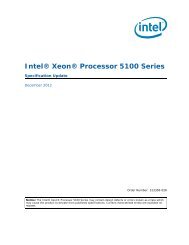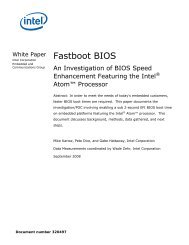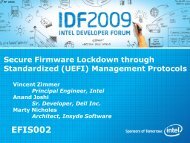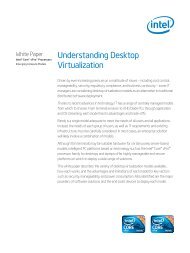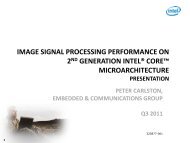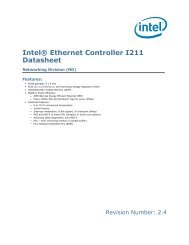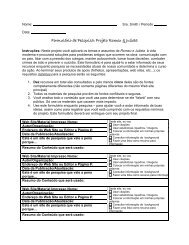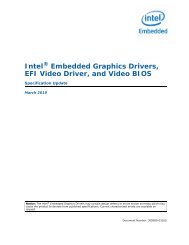Minimal Intel Architecture Boot Loader White Paper
Minimal Intel Architecture Boot Loader White Paper
Minimal Intel Architecture Boot Loader White Paper
You also want an ePaper? Increase the reach of your titles
YUMPU automatically turns print PDFs into web optimized ePapers that Google loves.
<strong>Minimal</strong> <strong>Boot</strong> <strong>Loader</strong> for <strong>Intel</strong>® <strong>Architecture</strong><br />
Stack Setup<br />
The stack must be setup before jumping into memory. A memory location<br />
must be chosen for stack space. The stack will count down so the top of the<br />
stack must be entered and enough memory must be allocated for the<br />
maximum stack.<br />
If the system is in real mode, then SS:SP must be set with the appropriate<br />
values. If Protected Flat Mode is used, then SS:ESP must be set to the<br />
correct memory location.<br />
Transfer to DRAM<br />
This is where the code makes the jump into memory. As mentioned before, if<br />
a memory test has not been performed up until this point, the jump could<br />
very well be to garbage. System failures indicated by a POST code between<br />
“end of memory initialization” and the first following POST code, almost<br />
always indicates a catastrophic memory initialization problem.<br />
Miscellaneous Platform Enabling<br />
Miscellaneous things in the system must be configured in the boot loader for<br />
proper operation. The only way to know what has to be programmed is to<br />
review the schematics. The following things are typically required to be<br />
programmed, but it is platform dependent:<br />
<br />
<br />
Clock Chip programming<br />
GPIO configuration – Refer to the Chipset BIOS Writers Guide for more<br />
details.<br />
Interrupt Enabling<br />
IA has several different methods of interrupt handling. The following or a<br />
combination of the following can be used to handle interrupts:<br />
Programmable Interrupt Controller (PIC) or 8259<br />
<br />
<br />
<br />
Local Advanced Programmable Interrupt Controller (APIC)<br />
Input / Output Advanced Programmable Interrupt Controller (IOxAPIC)<br />
Messaged Signaled Interrupt (MSI)<br />
Programmable Interrupt Controller (PIC)<br />
The PIC contains two cascaded 8259s with fifteen available IRQs. IRQ2 is not<br />
available since it is used to connect the 8259s.<br />
12




